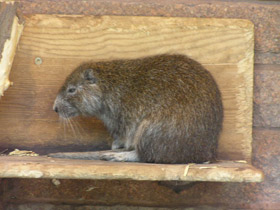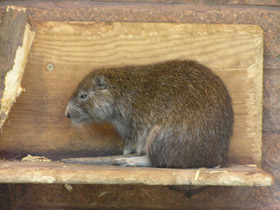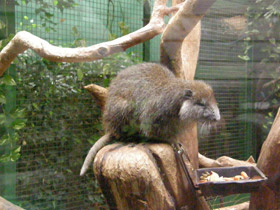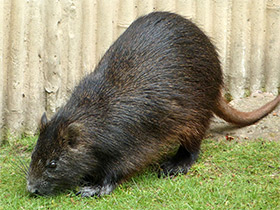Family Hutias Capromyidae
The Desmarest’s hutia Capromys pilorides
Desmarest’s hutia видео
The Desmarest’s or Cuban hutia is a large rodent of Capromyidae family and the only member of the genus Capromys. The Cuban hutia is endemic to Cuba. It is the largest of the extant species of hutia: the body length of the Cuban hutia can reach 70 cm (typically from 30 to 60 kg) and weight may be up to 9 kg. The Cuban hutia somewhat resembles the nutria and some scientists even assign both species to the same family. The Cuban hutia has long, strong tail covered in thin, coarse hairs. The fur is thick and coarse and the colour on the upper parts can be various shades of black, grey, brown, red, yellow, and cream. Cuban hutias have no undercoat. They have stocky bodies, short limbs, and large heads. The snout of this rodent is wide and blunt; the eyes and ears are small. Their feet are broad and each foot has five toes with prominent claws which these animals use for climbing trees.
Cuban hutias live only in Cuba and on several small nearby islands. They inhabit tropical forests, preferring habitats situated close to water. Hutias favour lowlands but also live in the mountains of eastern Cuba. They spend most of the time on the ground and climb on trees for feeding and sunbathing. When sunbathing, the hutia may curl up in a ball which looks like a pile of leaves from below. Although hutias live in pairs, they do not mind having neighbours. Even scent marking behaviour of these animals is aimed at communication with other hutias rather than at scaring off any competitors. Large colonies may number up to 30 animals per one hectare but these rodents do not demonstrate aggressive behaviour towards other representatives of their species. Cuban hutias do not dig burrows and use tree hollows, rocky crevices, and abandoned burrows of other animals for sheltering. Sometimes hutias use mangrove branches and leaves to build huge nests measuring up to one meter in diameter, and masterfully camouflage these nests in mangrove thickets. After gestation period of 120-130 days, Cuban hutia female gives birth to 1 to 3 young. The young are born precocial, able to move around, well-furred, and with their eyes open. They grow fast and are able to feed independently by the age of five months. Young hutias reach sexual maturity by ten months of age. In the mild climate conditions of Cuba, hutia females are able to breed twice a year. Births may occur all year round. Cuban hutias are active in the daytime. They are omnivores that generally feed on vegetation such as leaves, fruits, and tree bark, but occasionally can also eat small lizards, insects and other small animals. Local people find hutia meat tasty and sometimes hunt hutias. Under Cuban law, it is illegal to hunt or kill hutias without a special license issued by the Ministry of Agriculture and Fishery. It should be noted that this species is found in many protected areas in Cuba. The Cuban hutia is easily tamed, quickly adapts to captive environment, and successfully breeds in captivity.



















































